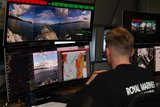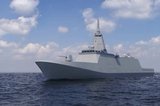Saab signs modernisation deal for Sweden’s coastal anti-ship missile capability
An impression of how the SBS15 MK3 would work to keep Sweden's coastline safe. (Image: Saab)
In its third contract with the Swedish Defence Materiel Administration (FMV) in a month, Saab has signed a deal to modernise Sweden’s coastal anti-ship missile capability.
The total order value is SEK 800 million (US$72 million) and deliveries will begin in 2026.
The contract includes Saab’s RBS15 Mk3 anti-ship missile, integrated on a launcher module installed on a truck. Sweden currently uses the predecessor RBS15 Mk2 model.
Related Articles
Germany and Finland suspect “hybrid sabotage” of undersea infrastructure
Swedish Navy and Saab sign deal on autonomous mine countermeasures vessels
Saab Sea Giraffe to protect Swedish Navy
A coastal anti-ship missile capability was reintroduced into the Swedish Armed Forces in 2016 and will now be complemented with the RBS15 Mk3 on new launcher platforms.
Görgen Johansson, head of Saab’s business area Dynamics, said: “Sweden will receive a significant capability increase with an anti-ship missile featuring a more advanced target seeker, increased range and a larger warhead. RBS15 has been specifically developed for the complex environment and harsh weather conditions of the Baltic Sea.”
RBS15 Mk3 has a range of over 200 km, can be launched from ships and trucks and is primarily used against naval targets. The system was developed and produced by Saab and its German partner Diehl Defence.
Countries with Baltic Sea coasts have recently had what they believe are legitimate reasons to intensify their defences. Following the apparent severing of some subsea cabling in November, Germany and Finland spoke of the likelihood of “hybrid sabotage” of their underwater infrastructure.
Swedish Prime Minister Ulf Kristersson went on to convene a meeting of Baltic coast leaders in the last week of November, at which Polish Prime Minister Donald Tusk proposed a joint venture to ensure maritime security in the Baltic.
Since that meeting, the FMV has signed three contracts with Saab to tighten up its coastal security. The first was to improve Sweden’s autonomous mine counter measures, allowing for faster, more accurate mine counter measures to be undertaken with reduced human risk.
The second saw an agreement to deploy Saab’s Sea Giraffe naval radar, which can be particularly effective against small UAVs, with which some legacy radars struggle.
Now Saab is boosting coastal defences in Sweden with its anti-ship missile capabilities.
It remains to be seen whether other Baltic Coast states adopt similar protections in coming months.
Related Equipment in Defence Insight
More from Naval Warfare
-
![NATO tests use of “undetectable, jam-proof” laser communication in maritime scenarios]()
NATO tests use of “undetectable, jam-proof” laser communication in maritime scenarios
As part of its effort to better prepare its capabilities for operations in contested and congested scenarios, NATO evaluated a Lithuanian ship-to-ship terminal designed to not be susceptible to enemy interference.
-
![US Navy advances with the Harpoon Service Life Extension Programme]()
US Navy advances with the Harpoon Service Life Extension Programme
The US Navy plans to improve Harpoon’s anti-ship and land attack capabilities by equipping the missiles with sensors and technologies required for succeeding in future battlespace.
-
![Mitsubishi eyes future with Australia’s Mogami selection]()
Mitsubishi eyes future with Australia’s Mogami selection
With Australia’s selection of the Mogami-class for Project Sea 3000, Mitsubishi is investigating local production in the next decade as potential export opportunities emerge.
-
![Thales’ new Sonar 76Nano could equip UK Royal Navy on anti-submarine warfare missions]()
Thales’ new Sonar 76Nano could equip UK Royal Navy on anti-submarine warfare missions
The new sonar is designed to equip uncrewed underwater vessels, with the potential to be used by the Royal Navy for its Atlantic Bastion and Atlantic Net missions.
-
![Hanwha wins Australian government approval to increase its stake in Austal]()
Hanwha wins Australian government approval to increase its stake in Austal
The contract would mean the two shipbuilders can collaborate strategically and enhance shipbuilding capabilities in Western Australia.























